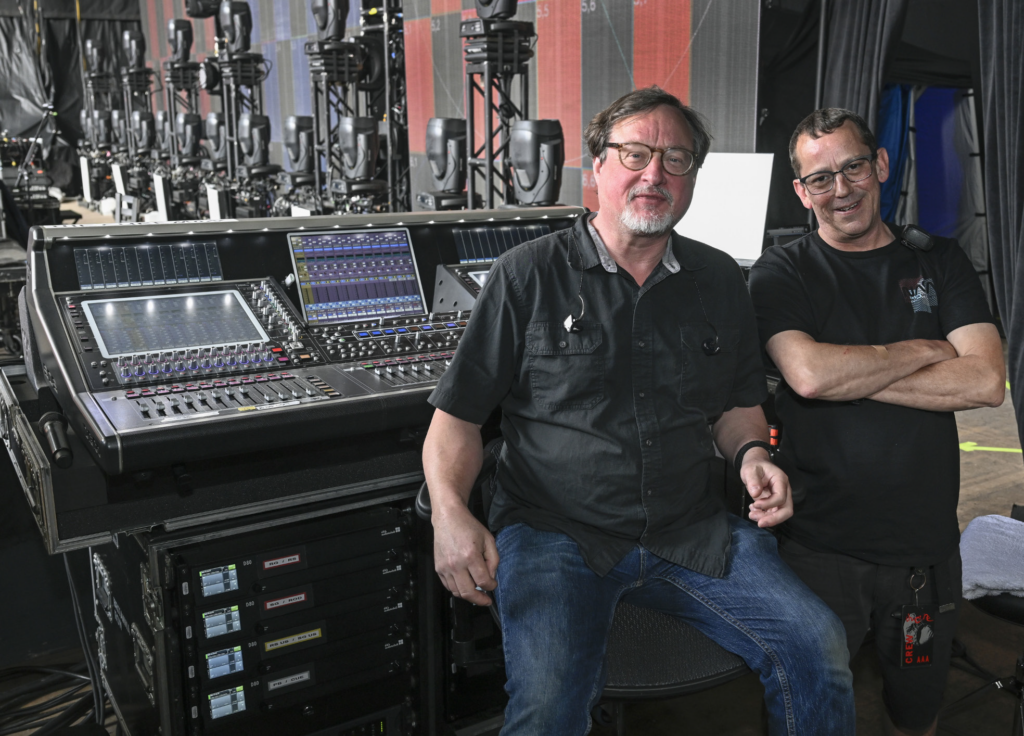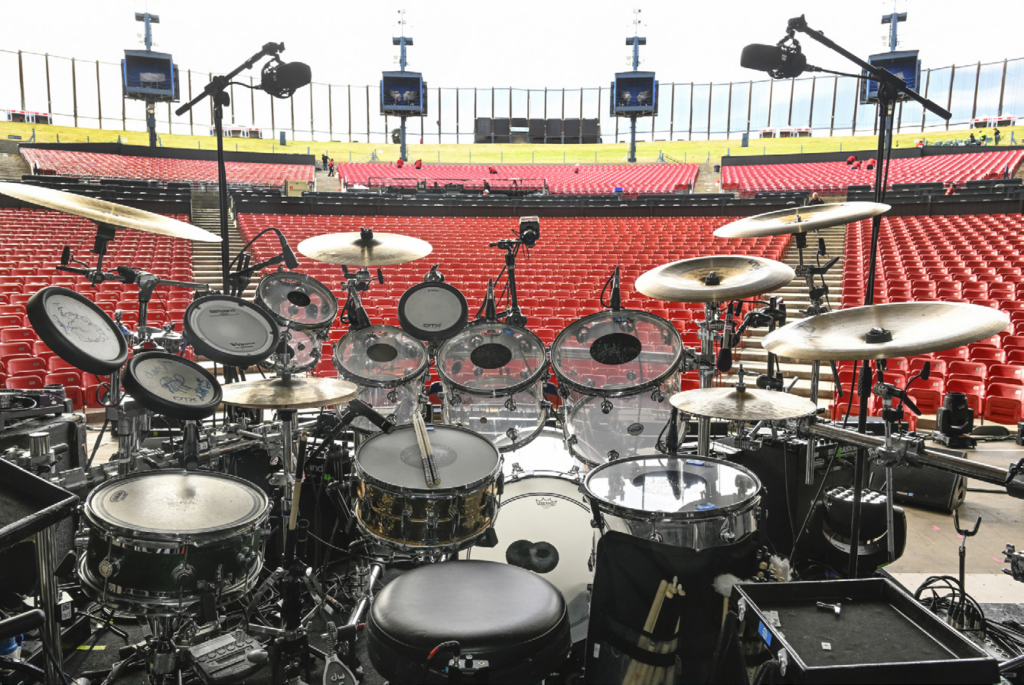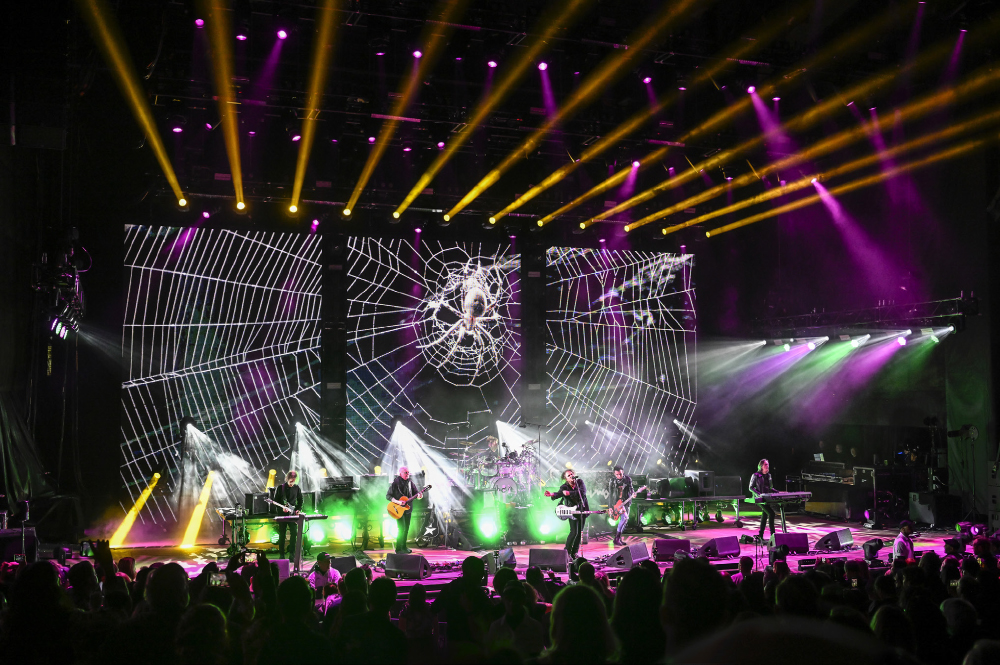It’s been a big welcome return for The Cure on their North American Tour this year with a show clocking in at almost three hours. They’ve always been a top-notch rock band, singer-songwriter, guitarist and band visionary Robert Smith sounds great as ever, and they’re entertaining fans with exceptional song choices in their set at every show. With so many quick sell-outs on the tour, the band has added shows to the tour, such as the one at the Shoreline Amphitheatre in Mountain View, CA that I attended.
Formed in West Sussex, England in 1978, with a mix of altrock, post-punk, goth/new wave, the band’s lost nothing over time in terms of its performances. I spoke with the tour’s front of house engineer Paul “Corky” Corkett, systems engineer Colin Burrell, monitor engineer Rob Elliott and PA engineer César López López for insights on their work with The Cure.
FOH engineer Paul “Corky” Corkett. He’s also a studio mixer and producer who got his start in the mid 1980s working with artists such as Nick Cave and The Bad Seeds, Bjork, Tori Amos, Placebo and The Cure, to name a few. After being studio-based for many years, in 2008 began mixing front of house on the road. In 2011, The Cure’s Robert Smith asked him to mix them live, and he’s mixed every show since then. Corkett says his time is split 50/50 in the studio and mixing FOH on tour.

“The studio I feel is a very special place. You create an ideal setup and layout for the band, a good line of vision and make the studio as comfortable as possible. One has the choice of isolating drums, bass and guitar amps. Being able to record from the live room or the control room, basically is setting up the most creative environment and one that you can spend long hours in without getting fatigued.”
Mixing the band live you have so many more factors to deal with, he adds. “When in arenas you are just dealing with the room and its character and how it responds to having a loud stage with 18 wedges hitting the back wall. When we are doing shows in sheds or at those outdoor festivals its more about weather and temperature. Wind is my pet peeve.
“When I started mixing The Cure we were using a Digidesign Profile [console]. We only updated last year to the Avid S6L. It was a logical move as we had around 130 songs and relevant snapshots that translated to the S6L. We record all our shows to two Pro Tools rigs via AVB. Robert then has the ability to mix shows for broadcast, etc.”
Corkett says Smith knows exactly how the songs should sound: “We rehearse before a tour and record everything. I send my mix to our lighting team, where they’re running a Whizz rig. Robert can then take home an audio and visual recording of the rehearsals. He will listen, watch and make notes of what needs refining. After a couple of weeks we usually do two or three days full production rehearsals. At the start of this tour, we were in Smoothie King Center in New Orleans for two days, then we did our first show there and then worked our way across the west.”

include Perry Bamonte (guitar), Reeves Gabrels (guitar), Jason Cooper (drums), Simon
Gallup (bass) and Roger O’Donnell (keyboards). (Photo Credit: Steve Jennings)
Mixing on the Avid S6L 24 frame, systems engineer Colin Burell and Corkett looked at their options, also considering a Midas 3000 and carrying a few bits of outboard. “I then went to Robert and gave him a few options; he thought the most logical step was to move from the Profile to the S6L and to have all our settings migrate,” Corkett says. “The desk is very versatile, you can really assign anything, anywhere. I keep our setup very simple. The main thing is that the desk sounds good.”
He runs about 75 inputs plus recording audience mics – four at front of house and two off the stage: “I hardly use anything, just a little EQ. When I started in rehearsals back in 2011, I was running a few reverbs, some delays. Robert then said to me that the only plugin I would need would be a delay for the vocal, nothing else. It’s vital to hear the band play if they hit a song like ‘Burn’ or ‘“’From The Edge Of The Deep Green Sea’.
“He wants to feel the dynamics of the playing and power of the band, so hardly any compression is used, plus with the size of the venues they usually have an inherent reverb.”
Corkett carries a Waves Max BCL hardware unit, occasionally employing it when a venue has strict sound level limits. “We also carry a Waves ‘brain’ for a choice of a few plugins but hardly use any to be honest,” he notes, adding that he can learn something new everyday and loves it.
“The band has a large catalog of songs and the set will change quite a lot. It’s nearly a three-hour show, extremely dynamic,” he says. “The stage is loud and one thing I have learned is not try and ramp up the PA volume too much otherwise the venue can come back at you. I have learned from Robert to get a balance that is quite narrow in the stereo field. It means that the audience can have a listening experience where they hear everything and not one amp far left or super wide toms. It works well with The Cure, and at festivals the broadcast is taken from my left right bus. Then sent to a broadcast truck where they will add in 20 percent audience mics.”
Corkett concludes that working with the band is always a great experience: “Robert is a fantastic songwriter, vocalist, guitarist and it’s a pleasure working with him. Bassist Simon Gallup plays a huge part in all their songs, he’s very powerful and melodic… he covers a lot of territory. With Jason Cooper’s superb drumming, guitarists Reeves Gabrels and Perry Bamonte and Roger O’Donnell on keys, you couldn’t ask for a better, tighter band, all adding extra depth to the songs. I have to thank our excellent production and crew, such a good bunch of guys keeping the tour going from country to country.”

Monitor engineer Rob Elliott. He’d been mixing on a DiGiCo SD5 for about eight years before making the decision to upgrade to the Quantum 5 last year before the band’s European tour. “I like its usability and workflow capabilities, I’ve been really happy with it,” he explains. “My setup is very simple and it works – no plugins and no outboard rack gear is needed.”
He’s been mixing monitors for the band for about 17 years and says, “It’s been enjoyable, my experiences mixing them as both a four-piece and for a while the current six-member band is that I can’t think of any audio situations that we’ve had to overcome in that whole time.”
None of the long row of amps lined up across the stage – HIWATT, Roland, Mackie and Cure (no relation to the band) – are miked, and there are no ISO cabs either. They are direct input.
“The Mackies are part of the keyboard rig that are there to balance the look of the backline on stage,” he adds. “I feed keys into them to give a bit of volume on SL. Jason Cooper’s drum kit mic package consists of a Shure B52 and B91 for the kick, Shure SM57s for the snare, Shure KSM137s for the hi-hat, Sennheiser 604s on toms, DPA 4099s for cymbals and AKG 414s for overheads.”
Systems engineer Colin Burrell. He begins by noting that he’s been quite happy with the L-Acoustics-headed main system for the tour. “We’ve been using K1s since Britannia Row first bought it, having done their first tour with them around 2008. So I’ve used it in quite a variety of situations over the years.” (By the way, the band first started working with Britannia Row Productions since the late 1970s, and with that long a relationship it makes them one of the oldest clients for the company.)
Burrell adds that the evolution of Soundvision and Network Manager over the years has made it quite easy to know what the rig’s going to be like before even unloading the truck: “The LA12X amplifiers certainly have all the power and DSP to pretty much do whatever you want. César López López is our L-Acoustics guy on this tour, and is extremely good at writing the ‘menu de jour.’ I’ve been to most of the places on this tour a few times now so I provide him on occasion with some notes-old recipes, but mostly I join the dots between César and Corky, who is also a great studio mixer, making sure that its all going to translate well to that days environment.”

K1 and K2 arrays and flown KS28 subwoofers, with more
KS28s on the ground. (Photo Credit: Steve Jennings)
He notes that López optimizes the system and deals with obvious odd-sounding venue specific things, and then they both listen to a selection of sound engineering’s greatest hits: “More specifically a few tracks from David Bowie’s Let’s Dance album, as tonally it has parallels to the sound of what’s coming off stage, and has all the bits in it that will let you know which frequencies need attention. César will then play ‘Now that’s what I call PA tuning music Vol. 2’.
“César and Corky will walk the room… César can find any nook that someone might end up hanging out in and make sure even they are going to have the best sound experience possible, filling areas with L-Acoustic X8s or other smaller boxes as required. A virtual sound check is used on occasion too as it’s an excellent tool for this sort of thing!”
Burrell has been working with the band for about 10 years now and has known “Brains” (Rob Elliott) for 20 years, so it’s a very familiar family feel. “The Cure camp do certainly work like no one else I’ve ever worked for. Robert is really involved in everything, all aspects of the tour from artwork, ticket prices, flights, what lighting will be used and look like, even which mixing consoles we use. It’s great to see someone so involved in everything, in the best way possible for the fans, the crew, everyone.”
Smith usually listens and watches a recording of each night’s show and emails notes to people about changes he wants to make: “They’re always sensibly written and carry his sense of humor well.”

and Shure microphones. (Photo Credit: Steve Jennings)
Burrell notes that his role is kind of an odd one – he keeps a bit of an eye on the audio and backline and pops in every day to the stage end to do a bit of radio spectrum management using the new Shure Axient AD600, which he says is great, to make sure everyone is happy and everything is working as it should.
“Having worked with Corky for so many years now, it’s quite a symbiotic workflow, and we’re certainly OK with being direct about what we think about something. It’s quite a fun environment and definitely a bit of a family,” Burrell concludes, giving a shout-out to the tour’s two PA riggers, Claus Köpplin Orrán and Marty Lee.
“Claus is a youngster but he really is best at calmly, quietly and very quickly putting up the stage left PA. I certainly don’t have any complaints with Marty either in putting up stage right PA. It’s great to have them with us. Then another shout-out to Robin Scott, who took over production manager duties and is loved by all!”
PA engineer César López López. He expounds on the rig for the tour, noting that its “mainly K1 with K2 under hangs for mains, side and delays. The 270-degree [rear hang] is K2. We have a left-right flown sub [configuration] beside the mains – eight KS28s per side. On the ground, there are eight KS28s across the front with six single A10s on top and a block of four A15s on the ends as frontfills.”

that are also supporting L-Acoustics A10 fill loudspeakers. (Photo Credit: Steve Jennings)
López says the configurations vary for sheds, to adapt the show to the specific venue and often with weight limits in place: “In these kind of venues, the 270-degree hangs are not always needed; the other major difference is that some of the venues allow us to fly some of the subs but not all. We also use the lawn systems the venues provide as delays.
“For tuning the PA, it’s L-Acoustics M1 along with [Rational Acoustics] Smaart giving a solid combination with good results. I’m doing the measurement and timing process, then Colin [Burrell] and I get to the final result together. The L-Acoustics integration during the design has been really helpful. Giving a good starting point before the process of tuning starts, making for a real time-saver.”















